Upper Reka
Upper Reka (Macedonian: Горна Река, Gorna Reka; Albanian: Reka e Epërme) is a geographic and ethnographic subregion of the broader Reka region of western Republic of Macedonia, including settlements within the upper left portion of the Municipality of Mavrovo and Rostuša and of Gostivar Municipality. The region is home to both a Muslim Albanian community and Christian Orthodox Albanian speaking population that self identifies as Macedonians,[1][2] though with some notable exceptions in past and recent times.[3][4][5][6][7]

Upper Reka is an alpine mountainous and rugged region with animal grazing and highland pastures. In contemporary times, the largest inhabited settlement is the village of Vrbjani.[8] Upper Reka is an isolated and underdeveloped region with limited communication links, whereby access and travel becomes difficult during the snowy winter months.[9]
Historically Upper Reka inhabitants mainly engaged with agricultural and farming activities of which some of the remaining population continues to do.[10] The region has experienced much depopulation over time due to seasonal or permanent migration to nearby regions and abroad in search of employment and better living standards.[11] In the 14th century Upper Reka was part of the Lordship of Prilep, of the Mrnjavčević family, until 1395, when its territory was subjugated to Bayezid I of the Ottoman Empire under which it remained until the Balkan Wars of 1912-1913. Thereafter it became part of Kingdom of Serbia, the Kingdom of Yugoslavia, the Socialist Federal Republic of Yugoslavia, and eventually part of the Republic of Macedonia.
Geography and Environment
Location
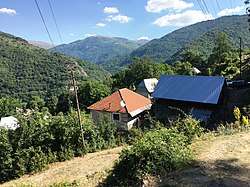
The broader Reka region is divided into Mala (small), Dolna (lower) and Golema (large) or Gorna (Upper) sub-regions (ethnographic/geographic regions).[12] Upper Reka alongside the wider Reka region was also considered (and from an Albanian point of view still considered) to belong to the larger region of Dibra that encompasses multiple sub-regions centered around the town of Debar on both sides of the Albanian-Macedonian border.[13]

The region of Upper Reka is bordered by Kosovo to the north and by Albania in the west.[14] It is a mountainous area with highland alpine pastures, situated at the northern end of the Radika river basin that continues on into Lower Reka all the way to the southern Boškov Bridge, near the area of Small Reka.[14] Upper Reka's northern and northeastern territorial borders consist of the Vraca Mountains which are part of the wider Šar Mountains that extend nearby as the Ničpur Mountains with Lera peak at 2194 m.[14] The northwest and western borders of Upper Reka go along the Korab Mountains with Golem Korab peak at 2753 m.[14] A narrow pass at 1920 m above sea level, between the Korab and Šar Mountains exists that allows for communication and interaction with the ethnographic/geographic Gora region.[14] Through this opening, located between the three point border mountain peak of Ksulje e Priftit at 2092 m and the Vraca Mountains is the most suitable communication link (consisting of an automobile road, pedestrian and mule paths) between the former village of Štirovica at the extreme northern end of Upper Reka and Restelica village at the southern edge of the Gora region in Kosovo.[14]
The southern border of Upper Reka is on the right side within the valley of the river Radika.[14] It is between the villages of Vrbjani in Upper Reka and Žirovnica in Lower Reka that are represented by geographical and communicative limitations presented by the imposing Korab Mountains.[14] A road links both villages and is the main outlet for transitory communication between within the area that goes all the way to Debar.[14] The eastern part of the southern border from the left side of the Radika river valley fully belongs to the Bistra Mountains with Medenica peak at 2163 m.[14] An eastern road that intersects with the others at Volkovija village heads toward near Vrben village at Upper Reka's eastern limits.[14] Onward that road continues toward to Mavrovi Anovi town and Mavrovo Lake and further on to Gostivar. Apart from the main Radika river, a series of tributaries that feed it are found throughout Upper Reka such as Dlaboka Reka (Albanian: Përroi i Thellë), Brodečka Reka (Ujë të Vaut, also Uji i Vaut), Ribnička Reka (Përroi i Rimnicës) and so on.[14][15] Highland mountain alpine pastures used for livestock grazing by the local populace are found throughout the mountainous region such as Rečka Planina (Bjeshka e Reçit), Nistrovski Korab (Korabi i Nistrovës) and Ḱafa Kadis (Qafa e Kadisë).[14][15] In total, the confines of the Upper Reka region covers an area of about 358.8 square kilometres (138.5 sq mi).[14]


Settlements
Upper Reka settlements within Mavrovo and Rostuša Municipality include Tanuše (Tanushaj), Nivište (Nivisht), Ribnica (Rimnicë), Žužnje (Zhuzhnjë), Nistrovo (Nistrovë), Ničpur (Niçpur), Volkovija (Vallkavi), Kičinica (Kiçinicë), Krakornica (Krakarnicë), Beličica (Beliçicë), Vrben (Vërben), Bogdevo (Bogdë), Sence (Sencë), Vrbjani (Vërbjan), Bibaj and Grekaj. Upper Reka settlements within Gostivar Municipality are Brodec (Va, definite form: Vau).[16][17] Traditionally three other adjacent villages, Duf and Orḱuše (Orqushë) in Mavrovo and Rostuša Municipality and Gorno Jelovce (Jalloc i Epërm, also Jallofcë e Epërme) all within the neighboring Upper Polog region have at times also been considered belonging to Upper Reka, due to linguistic affiliations and cultural connections.[18][19][20][21] Also due to uprisings in the Upper Reka region, former settlements such as: Trnica (Tërnicë), Reč (Reç), Dubovo (Dëbovë), Štirovica (Shtirovicë), Strezimir (Shtrezmir) and Zavojsko (Zavojskë) were burned down by Serbian and Bulgarian forces between 1912–1916.[22][23]
Climate, fauna and wildlife
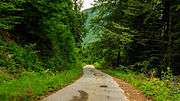
The Upper Reka region is the only area within Macedonia to have a cold Alpine climate. Due to the high altitude, the region is exposed to winds from various directions.[24] From the east, the strong gusts of what Upper Reka locals refer to as era bardh, literally the white wind, the rain-bringing warm southeast wind ladas and the northwest wind heralding weather change called era poshtr or low wind.[24] The region is exposed to thunderstorms mainly during summer, while rain, frost, hail and rainbows occur according to seasonal weather patterns.[24] The winter season is often long and snowy and so too is the summer season, while spring and autumn seasons are short.[9] Snow mostly appears in the region from the middle of autumn lasting until mid-spring.[9] It recent times snow fall continues late into spring and even at times into early summer.[9] Due to snow fall, Upper Reka becomes an isolated region as communication for most of the year with neighbouring areas is severely limited and even impassable such as that with Albania through the Korab Mountains.[9] In past times, the population was forced during the short summer season to supply food grains, salt, beans and other food stuffs as snow made communications difficult between nearby villages and the outside world.[9] Most of Upper Reka along with Dolna Reka is located within Mavrovo National Park.[25] In the area of Upper Reka, parts of the region still contain virgin forests of old and unique species of Beech trees (Abies borisii-regis) especially around Dlaboka river and the northern part of the Radika river valley.[26] Parts of Upper Reka forests were felled until the 1950s to create pastures for sheep grazing.[26] Upper Reka is also home to the critically endangered subspecies of Eurasian lynx, the Balkan lynx (Lynx lynx balcanicus).[26][27]
Demographics
Population and Identity


Upper Reka is inhabited by Muslim and Christian Albanian speaking people referred through demonyms in Macedonian as Gornorekanec (plural: Gornorekanci)[12] and Rekali (plural: Rekalinj/të) in Albanian.[28][29] By outsiders they are referred to as Shkreti,[30] from the Albanian word and expression shkretë/i shkret meaning the poor ones, due to their isolated mountainous homeland and difficult living circumstances.[31][32] Of the Albanian speaking populations who remained Christian Orthodox, they assimilated and identify as Macedonians,[1][2] while those who embraced Islam consider themselves Albanians.[2] Due to the migration of Orthodox Christians to urban centers a few decades ago, today the majority of inhabitants are Muslim Albanians, with a minority of Orthodox Albanian speakers, who self-identify as Macedonians.[33] The largest Muslim Albanian settlement in Upper Reka today is Vrbjani with 625 inhabitants.[8] While the main Orthodox settlement today is Vrben with 142 inhabitants.[8] In Upper Reka, households are called shpi (Standard Albanian: shtëpi) or literally house and traditionally consisted of patriarchal extended families.[34][35] These families, some affluent ones, lived in large and at times fortified multi story stone dwellings called kulla or tower house while other families had smaller houses.[36] The adjacent Lower Reka or Dolna Reka region is inhabited by Macedonian Muslims (known as "Torbeši" or "Turks" i.e. Muslims), whereas a minority are Orthodox Macedonians. Small Reka, or Mala Reka, meanwhile, is inhabited solely by Orthodox Macedonians and the populations of Small and Lower Reka belong to the Slavic ethnographic group of Mijaks, who speak the Macedonian Reka dialect.
Economy and Seasonal/Permanent migration
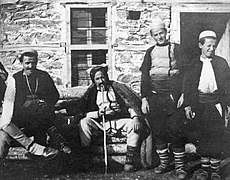
Due to difficult living circumstances and at times sociopolitical disturbances, especially in the 19th century, Upper Reka has historically been a region with much outward temporary and permanent migration.[11] Traditionally the population was mainly engaged with animal husbandry and agricultural activities which some of the small remaining population still carry out.[10] As such during the late Ottoman era, Upper Reka males (mainly adults) would seasonally go on kurbet or economic migration.[37] Often they would find employment as pastry makers or as halva, salep and boza merchants and salesmen in the then Ottoman capital Istanbul or regional cities like Skopje and Edirne.[38] In Romania and Bulgaria, some Upper Reka people were also employed in the housing construction industry as stonemasons or builders and likewise when the need arose in cities such as Shkodër or their local area too.[39][40]
Permanent migratory flows during the late Ottoman era were mainly to neighbouring villages and regions where today these populations often form few households within a settlement amongst their wider Albanian population.[11] In the region of Upper Polog, Upper Reka people relocated to the following villages: Čegrane, Forino, Korito, Balin Dol, Malo Turčane, Dolna Banjica, Sretkovo, Novo Selo, Rečane, Vrutok, Pečkovo, Zdunje, Vrapčište, Kalište and Gradec.[11] In Lower Polog: Gorno Sedlarce, Rakovec, Žerovjane, Radiovce, Tenovo, Lukovica, Sedlarevo and Gurgurnica.[11] In villages within the vicinity of Skopje city: Crn Vrv, Krušopek, Sveta Petka and Patiška Reka, while near Veles at: Gorno Jabolčište, Sogle, Klukovec and Buzalkovo.[41][11] In some villages, the Upper Reka population migrated there as Christians like in Lukovica and only converted thereafter to Islam.[42] While in Patiška Reka, they remained Orthodox and Albanian speaking until World War Two,[43] before relocating to Skopje thereafter.[41] Some Upper Reka residents from Vrbjani have in recent decades migrated to the neighbouring Muslim Macedonian village of Žirovnica with municipal services in Lower Reka and number some 258 people.[44] While Orthodox Christians migrated from the 1950s onwards to the then Yugoslav capital Belgrade, other cities like Skopje and to nearby Gostivar town where they form the main population of Durtlok neighbourhood.[29][32][33] Due to the 2001 insurgency in northern Macedonia, the village of Tanuše was affected by the conflict which made some residents migrate thereafter to other places.[45][46] Young Upper Reka people in recent times have also emigrated to Western countries,[10] while some older inhabitants return to their homes in Upper Reka during the summer period.[29]
Language and Culture
Upper Reka Albanian dialect
The Albanian Upper Reka sub-dialect belongs to the larger Gheg dialect spoken by Northern Albanians.[47] In contemporary times, Muslim Albanians residing in Upper Reka are to varying degrees also bilingual in the Macedonian language.[33] Amongst the Orthodox population still residing in Upper Reka, in terms of daily speech are mainly fluent in Albanian amongst themselves and even the young.[48]
Observances, Customs and other folk culture
In Upper Reka, a number of secular and religious holidays are celebrated. Secular celebrations are Diten e Vers (first Day of Spring) celebrated March 1.[49] The main Orthodox Christian celebrations are Shnkrysh (Feast of the Cross) and Blagavesht (the Annunciation).[49] Other important celebrations are the feast days of saints such as Shingjergj (St. George), Shumtanas (St. Athanasius), Shmitr (St. Demetrius), Shën Eremia (St. Jeremiah), Shën Mëria (St.Mary) and St. Barbara.[49][50][51] Muslim celebrations are Sultan Nevrus (Nowruz), Ramadan and the two Bajrams (Eid al-Fitr, and Eid al-Adha).[49] The traditional clothing of Upper Reka, though sharing similarities with clothing of surrounding areas, is known for its distinctive regional style and use of multiple colours, as well as complex floral and other patterns.[52]
History
Origins
Various positions exist about the origins of the Upper Reka population within Balkan related scholarship. One of the earliest authors to write about the matter was Serbian journalist Spiridon Gopčević. In his now discredited work regarding the Balkans,[53] Gopčević claimed that Upper Reka inhabitants were “Albanianized Slavs”.[54] In the late 1890s Štilijan Čaparoski and folklorist Panajot Ginoski, both from Galičnik, Dolna Reka, maintained that Upper Reka inhabitants spoke a corrupted form of Albanian that was understood only by the locals, and contained a mixture of Slavic and Albanians words.[55][56] Russian linguist Afanisiy Selishchev in the 1930s wrote that the inhabitants of Upper Reka were Slavs that underwent Albanianization, due in part to some toponyms being Albanian translated variants of Slavic forms.[57] Serbian ethnographer Toma Smiljanić from Tresonče, Dolna Reka stated that on the eve of World War I Upper Reka had 274 native households and 107 households with origins from territory in Albania and nine households from other regions.[58] Smiljanić affirmed that the Upper Reka population originated from a community of Serbs from the Peć surroundings that settled in territory once inhabited by Miyaks, and then mixed with Albanians and perhaps also Turks and Vlachs, adopting a mixed speech of Albanian and Serbo-Croatian with some Turkish linguistic influence.[58]
Due to some patronymic names of families, Serbian philologist Dušan Nedeljković contended a Vlach origin for some Upper Reka families, alongside Slavic origins that were Albanianized.[59] Historian Nick Atanasovski, who did fieldwork in Lower Reka contends that the sub-regions of Small, Lower and Upper Reka were subjected to Islamisation, though not colonisation.[60] While anthropologist Mirjana Mirčevska who did field work in Upper Reka during the 2000s, stated that both the Muslim and Orthodox population was mainly of Macedonian Slavic origin, with possible Albanian elements in their ethnogenesis.[61] Mirčevska recorded local Upper Reka traditions in Bogdevo, Krakornica and Ničpur that attribute the founding of those villages to three brothers: Boge, Krako and Niko who originated from the Kolašin region located in contemporary Montenegro.[62] During the 18th century Mirčevska contends the population was Islamised and Albanianized after the arrival of Catholic and Muslim Albanians from what is today Albania.[61] Mirčevska also states that the non-Slavic character and origins of some Upper Reka individuals in Ottoman defters and contemporary families are due to a Vlach origin.[61] This is based on past names and contemporary language terms regarding kinship originating from Aromanian and not Albanian.[61]
Vasil Kanchov, a Bulgarian ethnographer who compiled detailed ethno-linguistic statistics on Macedonia's then population wrote in 1900 that Upper Reka was inhabited by Muslim and Orthodox Albanians.[63] Kanchov wrote that their presence was old and may have also contained traces of an Albanianzed Slavic population.[63] Galaba Palikruševa, examining medieval Ottoman tax registers or defters of the region in the 1970s regarding personal names, stated that there was a prominent non-Slavic element in Upper Reka of Albanian and/or Vlach origin.[64] As such, Palikruševa contended that certain scholarship which stated that the contemporary Upper Reka population was Slavs who adopted the Albanian language to preserve their Christian faith is an untenable position.[64] Historian Dimitar Bechev regards the Christian populace of Upper Reka as Orthodox Albanian speakers,[1] whereas historian Noel Malcolm considers them to be Orthodox Albanians.[65] Albanian philologist Edibe Selimi-Osmani who did fieldwork in Upper Reka during the 1990s and 2000s regarded the population as being of Albanian origin.[66]
Linguist Qemal Murati, referring to both the Muslim and Orthodox population as Albanians argued that scholars who suggested the Upper Reka population are Albanianized Slavs have done so due to nationalist reasons so as to deny the historical Albanian element in the region.[67] Murati also states that certain Upper Reka Albanian vocabulary regarding kinship attributed to a Vlach origin does not suffice.[67] This is due to those Albanian words being direct borrowings from Latin that had not undergone an intermediate stage in Aromanian before entering the Albanian language.[67] In the early 2010s, scholar Andrea Pieroni and a team of researchers from various national backgrounds did fieldwork and a comparative study of past and present Upper Reka botanical terminology. In their findings they concluded that the Upper Reka population was one that “had been heavily influenced by the Slavic culture - and not vice versa, as Spiridon Gopčević stated.”[68] The research team attributed that acculturation process to the imposition of the border in 1912 limiting contact with Albania and extensive interactions with surrounding multiethnic regions where trade was undertaken.[68] In addition Slavic languages and culture played a role in that process due to they being the national and dominating ones of the state.[68] The team also identified that there was some Aromanian botanical terminology present in the Upper Reka dialect.[68]
Medieval Ottoman period
During the 14th century Upper Reka was part of the Lordship of Prilep, of the Mrnjavčević family, until 1395, when its territory was subjugated to Bayezid I of the Ottoman Empire. In 1467 Ottoman defters list the region of Reka as a vilayet and in Upper Reka there were 15 inhabited villages and 3 uninhabited ones.[69] The following villages recorded for the first time were: Štirovica, Ribnica, Vrben, Ničpur, Nistrovo, Volkovija, Žužnje, Brodec, Krakornica, Strezimir, and Ribničica (a former village), with Vrbjani being the largest settlement.[69] Beličica, Kičinica and Leskovo (a former village) were listed as uninhabited.[69] The villages of Nivišta, Bibaj, Grekaj, Reč and Tanuše where not registered as existing at that time.[69] Personal names in these villages show Slavic and Vlach and/or Albanian character.[64][70] In 1519, a few Muslim households are counted within Ottoman defters in villages like Vrbjani, Sence, Ribničica and Kučuk or Small Ribnica.[71] Some names recorded in those registers from a Vlach and/or Albanian derivation were: Vlashe Tanush, Gon Vlash, Duka or Doka Mihail, Lazar son of Kalina, Miho Shalis, Kirk Bard, Gin Sherk or Shirk, Gego Sherk and others.[64][70] Examples of names indicating a Vlach and/or Albanian derivation with a possible Slavic symbiosis were: Gerg son of Andreya, Dabich Loz/e, Progon Tome, Dzheko son of Gerg, Miho Meksha, Petko son of Miho, Pavle Sherk and so on.[70] By 1583, the number of Muslim households listed in Ottoman defters had increased making up a sizable minority in the villages of: Vrbjani, Sence and Vrben.[71] A few Muslim households began to appear in the villages of: Krakornica, Strezimir, Štirovica and Žužnje.[71]
Middle to Late Ottoman period


Intensive conversion to Islam occurred in Upper Reka from the late 18th century, and continued until the mid 19th century.[63] The village of Štirovica was the last settlement where its 30 remaining Christian households converted to Islam in 1855.[63] Various Muslim and Orthodox Upper Reka inhabitants still retain memories of family ties and distant common ancestors.[72] A small Catholic population was also present that stemmed from some Catholic Albanians who migrated to Upper Reka from nearby areas located in contemporary Albania and later became assimilated.[72]
Due to Upper Reka's isolation and difficult living conditions, some inhabitants turned to banditry during the 18th and 19th century while others migrated to cities and regions for work.[38][11] In the late Ottoman period the wider Reka area formed a nahiye or district with its centre in Žirovnica village that had administrative officials and a small army garrison.[73] Orthodox Christian villages of Upper Reka in the late Ottoman period either had a Bulgarian or Serbian village priest.[74] Due to the Macedonian struggle, these priests were sometimes replaced with one or the other depending on the fluid church allegiances of a settlement's Orthodox inhabitants.[74] Certain Orthodox individuals from Upper Reka during this time like Josif Bageri made significant contributions to the Albanian national awakening.[3][75]
Yugoslav period
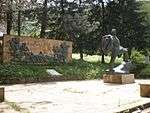
Ottoman rule lasted until the First Balkan War (1912–13) with the arrival of the Serbian army that annexed the region into Serbia. In 1913, Muslim Albanians of the region, led by imam Malik Mema, rose up against Serbian forces and managed to free the region and also some villages of the Gostivar area.[76] During World War I, local resistance continued as the region passed to Bulgaria. As such Serbian and Bulgarian forces during 1912-1916 burned down the villages of Trnica, Reč, Dubovo, Štirovica and Strezimir.[23] The region later became part of Kingdom of Yugoslavia. In 1941 after Yugoslavia's occupation by Axis powers, Upper Reka was attached to Albania by Fascist Italy.[77] Communist partisan resistance emerged from villages like Beličica that fought against Albanian fascist Balli Kombëtar forces which supported Upper Reka's inclusion into Albania.[77] On 19 September 1944, after 19 Partisans were captured, they along with 17 Beličica villagers were massacred by Ballist forces headed by Aqif Reçani near the area of the former village of Trnica.[77] After World War II, Upper Reka became part of Communist Yugoslavia. The region remained isolated and undeveloped which resulted in migrations to distant urban centres like Belgrade, Skopje and Gostivar, and to Western countries.[29][10][33]
Within Macedonia
Upper Reka became part of the Republic of Macedonia, when the Socialist Republic of Macedonia, a republic within Yugoslavia, gained independence following a referendum in 1991. During the 2001 Albanian insurgency some Macedonian military police, stationed in the village of Tanuše, damaged the village mosque to prevent its possible use by NLA guerrillas.[45] In recent times, there have been various forms of cultural revival within Upper Reka such as the festival Takimet e Rekës së Epërme (Upper Reka gathering) which was first held during August 2014 in the village of Ribnica.[78][79] A cultural association named Josif Bageri has also been established by some prominent Upper Reka members from both Muslim and Christian backgrounds aiming at socio-cultural, historical and linguistic preservation of Upper Reka heritage.[80] Meanwhile, amongst Upper Reka Orthodox Christians, controversies have arisen over identity and the church.[4][5][6][7][81][82][83][84][85] For example, a few prominent individuals like Branko Manoilovski from the Upper Reka Christian Orthodox community have publicly declared an Albanian identity or origin, while others such as Branislav Sinadinovski have called for an Albanian Orthodox Church to be present within the region.[4][5][6][7][82][83][84][85]
Gallery
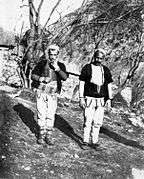 Two Upper Reka men: A man from Reč on the left and a man from Strezmir on the right.
Two Upper Reka men: A man from Reč on the left and a man from Strezmir on the right.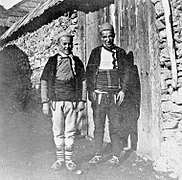 Two young men of Štirovica showing off opingas (shoes).
Two young men of Štirovica showing off opingas (shoes).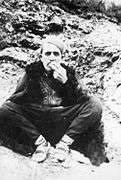 Man smoking, in the upper Reka valley near Debar.
Man smoking, in the upper Reka valley near Debar. Young Albanian in the upper Reka valley near Debar.
Young Albanian in the upper Reka valley near Debar.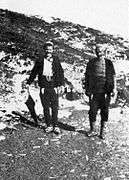 Albanians in the Upper Reka valley near Debar.
Albanians in the Upper Reka valley near Debar.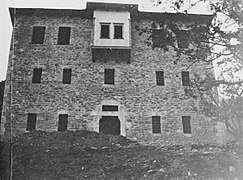 New kulla (tower house) in Brodec, 1907
New kulla (tower house) in Brodec, 1907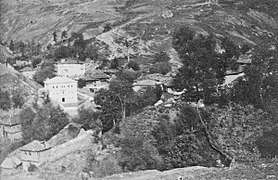 Brodec village, 1907
Brodec village, 1907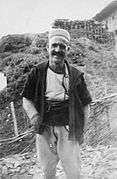 Albanian from Upper Reka valley near Debar, 1907
Albanian from Upper Reka valley near Debar, 1907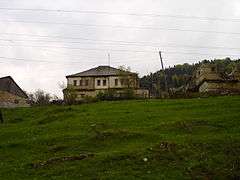 View from the lower neighborhood of upland houses, Volkovija
View from the lower neighborhood of upland houses, Volkovija- Korab motel located in area of former Trnica village
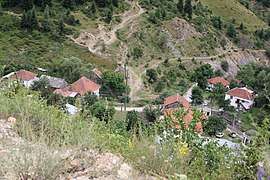 Vrben village
Vrben village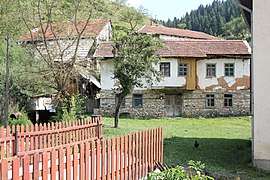 Upper neighbourhood, Vrben
Upper neighbourhood, Vrben Vrbjani village
Vrbjani village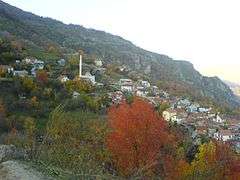 Autumn in Vrbjani
Autumn in Vrbjani Autumn season just prior to coming of Winter, Vrbjani
Autumn season just prior to coming of Winter, Vrbjani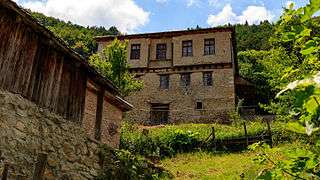 Old houses, Beličica
Old houses, Beličica View of Beličica village from nearby church
View of Beličica village from nearby church- View of Ribnica village
- View of Ribnica and Tanuše villages with peaks and mountain pass of Korabska Vrata in background
Notable people
- Josif Bageri, (born 1870 in Nistrovo - 1916) - a 19th-century Albanian national awakening activist
- Bajazid Elmaz Doda (born 1888 in Štirovica - 1933) - author, photographer and confidant of Baron Nopcsa
- Paskal Sotirovski (born 1927 in Vrben - 2003) - astrophysicist, specialist in Solar Physics.
- Branko Manoillovski, politician
- Mateja Matevski, writer
- Vidoe Smilevski, politician
References
Citations
- Bechev 2009, p. 188. "Several villages in the Upper Reka subregion were, in the past, populated by Orthodox Albanian speakers who have been largely assimilated by the Slavic Macedonians."
- Mirčevska 2007, p. 132."Горнореканците со муслиманска религија денес себе си се идентификуваат како Албанци, додека православите христијани како Македонци. [Upper Reka people of the Muslim religion today identify themselves as Albanians, while Orthodox Christians as Macedonians.]"
- Clayer 2007, p. 436. "Le journal comptait un peu plus d’une dizaine de collaborateurs reguliers. Âgés de dix-sept à trente-trois ans en 1902, il s’agissait, pour Ia plupart, de chrétiens orthodoxes originaires de la region de Korçë et vivant dans la diaspora. Un musulman du Sud, en l’occurrence Midhat Frashëri, qui collaborait déjà au Kalendari Kombiar, envoyait aussi des articles à la Drita. Il incarnait en fait les liens anciens noués entre les Albanais d’Istanbul et les diasporas de Roumanie et de Bulgarie. Un chrétien de la région de Debar, Josif Bageri, avait été intégré à ce réseau parce qu'il avait émigré à Sofia. [The newspaper had just over a dozen regular employees. Aged seventeen to thirty-three years in 1902, it was, for most Orthodox Christians from Korçë region and living in the diaspora. A Muslim southerner, namely Midhat Frashëri, who was already working at Kalendari Kombiar, also sent articles to Drita. It actually embodied the old links forged between Istanbul Albanians and the diaspora of Romania and Bulgaria. A Christian from the region of Debar, Josif Bageri, was integrated into this network because he had emigrated in Sofia]."
- Giorgievski, Branko. "Branslav Sinadinovski specijalen sovetik na liderot Ali Ahmeti: Liturgiite ne se dovolni, sakame posebna Albanska Pravoslavna Crkva [Branslav Sinadinovski special consultant to leader Ali Ahmeti: Liturgies are not enough, we want a separate Albanian Orthodox Church]". Dnevnik. Archived from the original on 8 December 2015. Retrieved 4 December 2015.
- "Škretite imaat makedonski koreni i ne možat da se poistovetuvaat so Albancite [Shkreti have Macedonian roots and can not be identified with Albanians]". Makedoncka Nacija. Retrieved 4 December 2015.
- "Kujt i pengon përkatësia etnike shqiptare e z. Sinadinovski?! [Who prevents the Albanian ethnicity of Mr. Sinadinovski?!]". Klan Macedonia. Archived from the original on 22 December 2015. Retrieved 13 December 2015.
- "Më thonë Branko Manojlovski, por unë jam shqiptar [The call me Branko Manojlovski, but I am Albanian]". Zeri. Archived from the original on 22 December 2015. Retrieved 13 December 2015.
- Book 5 - Total population according to the Ethnic Affiliation, Mother Tongue and Religion, The State Statistical Office, Skopje, 2002, pp. 167, 272.
- Mirčevska 2007, p. 24.
- Osmani 2012, p. 9. "Historikisht Reka njihet kyresisht si vend blegtoral. [Historically, Reka is known primarily for its stock farming]; p. 10. "Banorët që kanë jetuar dhe jetojnë në fshatrat e lartpërmenduara janë marrë dhe merren me veprimtari agrare-blegtori, kurse industria nuk është fare e zhvilluar. Shumë të rinj të kësaj ane herët kanë marrë rrugën e mërgimit. [People who have lived and still live in the above mentioned villages are farmers, and they deal with agricultural-livestock activities, therefore the industry is not developed at all. Many young people of this region migrated to Western countries.]"
- Mirčevska 2007, pp. 53, 280–287.
- Bužarovski & Bužarovska 2004, p. 46.
- Osmani 2012, p. 7. "Ndonëse Reka si toponim krahinë është unikal në tërë Shqiperinë dhe s’ishte e nevojshme që në emërtim të shtohej edhe një përcaktor vendor që bënte të ditur fqinjësinë me Rekën se psh. fjala e Dibrës, apo si gjejmë në kohët e ndryshme të jetë bërë zakon të thuhet: Reka e Dibrës, Reka e Tetovës apo Reka e Gostivarit, qytete këto fqinje me Rekën, ashtu sikurse është edhe Dibra. [Although Reka as a region toponym is unique in the whole of Albanian inhabited areas, it was not necessary to add the name Dibra, yet it became a custom to say: Reka of Dibra, Reka of Tetovo, or Reka of Gostivar, these neighbouring towns of Reka, as in Dibra itself.]"; p.8. "M. Tirta, shënon se Reka e Epërme, si veçori traditash shkon me krahinën e Dibrës, me qendër qytetin e Dibrës; shtrihet në viset malore në rrjedhën e sipërm të lumit Radika qe derdhet në Drinin e Zi. Si krahinë kemi Rekën, e ndarë në: Reka e Epërme, në rrjedhën e sipërme të Radikës, Reka e Poshtme në rrjedhën e poshtme të të njëtit lumë dhe Reka e Vogël. [M. Tirta notes that Upper Reka, with its particular traditions belongs to the region of Dibra, with its main town Debar. Its lies in mountainous areas upstream of Radika River, which flows into the Black Drin (Drini i Zi). As a region we have Reka, divided into Upper Reka, upstream of Radika river and Lower Reka in the lower course of the same river and also Small Reka.]"
- Mirčevska 2007, pp. 15, 22–26.
- Doda 2007, pp. 15–21.
- Osmani 2012, pp. 8–9.
- Mirčevska 2007, pp. 16–22.
- Islami 2011, pp. 137–138.
- Mirčevska 2007, p. 22."Село кое по сите етнички карактеристики е во групата на овие села (јазик, носија, брачни врски) е селото Дуф, кое во постојната етнографска поделба спаѓа во Горни Полог. [The village with all the ethnic characteristics which belongs to these villages (language, dress, marriage relationships) is the village Duf that in the current existing ethnographic division belongs to Upper Polog.]"; p. 283. "Сите жителина Горно Јеловце денес се билингвисти, освен македонскиот го зборуваат и албанскиот јазик. [All residents of Gorno Jelovce today are bilingual, other than Macedonian speak Albanian.]"
- Osmani 2012, p. 9. "Gjithashtu ka fshatra që nuk shtrihen buzë lumit Radika, si: Dufi me 5 lagjet e shpërndara: Çejani, Ballaboni, Arqevishi, Brezoveci, Tojlani. Ky fshat me lagjet e shpërndara traditën, veshjen, folklorin dhe të folmen e kanë të përbashkët me atë të Rekës së Epërme. Fshati Jellovcë e Epërme, ka tradita, veshje dhe gjuhë e dialekt të përbashkët, edhe pse janë në distancë të largët me Rekën e Epërme. [Also there are villages that do not near the mouth of the river Radika, like: Duf with its 5 scattered neighborhoods: Çejani, Ballaboni, Arqevishi, Brezoveci, Tojlani. This village with scattered neighborhoods tradition, dress, folklore and dialect have in common with that of Upper Reka. Upper Jelovce village, has traditions, costumes, language and dialect in common, although are some distance from Upper Reka.]"
- Kaso 2005, p. 134."Gorno Jellovce/Jellovcë e Epërme: Dikur ishte fshati i madh. Banorët, pa dallim të konfesionit fetar, kanë qenë shqipfolës. [Gorno Jellovce/Jellovcë e Epërme: It used to be a large village. The residents regardless of their religious affiliations have been Albanian speakers.]"
- Mirčevska 2007, p. 22.
- Osmani 2012, p. 9."Tërnica, Reçi, Boletini, Dëbova, Strezimiri, Zavojska dhe Shtirovica deri në vitin 1916 u dogjën nga serbët dhe bullgarët. [Tërnica, Reçi, Boletini, Dëbova, Strezimiri, Zavojska and Shtirovica until 1916 were burned by Serbs and Bulgarians.]"
- Doda 2007, p. 21.
- "Tourist map of the National Park "Mavrovo"". National Park Mavrovo. Retrieved 11 December 2015.
- Knapp 2013, pp. 11–12.
- Melovski et al. 2013, p. 88.
- Osmani 2012, p. 8. "Studiuesi M. Mitroviq thotë se në rrethin e Dibrës, me të fuqishmit janë shqiptarët. Në Dibrën e Epërme, që quhen Rekali, ka shqiptarë të krishterë dhe myslimanë. [Researcher M. Mitrović says that in Dibra district, Albanians are the more stronger element. In Upper Dibra, those that call themselves Rekali has Christian and Muslim Albanians.]"
- Mirčevska 2007, p. 138."Некои од нив имаат куќи во кои престојуваат во текот на летните месеци, додека другиот дел од годината живеат во Гостивар и Скопје, заедно со семејствата на синовите. [Some of them have houses staying there during the summer months, while during the other part of the year living in Gostivar and Skopje, along with the families of their children.]"; p. 162. "На пример, во Белград, каде и денес живее релативно голем број на горнореканцко македонско население, познати се како Рекалии. [For example, in Belgrade, where today lives a relatively large number of Macedonian Upper Rekan population, who are known as Rekalii.]"
- Evans 2012, p. 48. "The Gorna (Upper) Reka region, from the village Brodec to the village Volkovija is mostly abandoned today, but, in the past, was inhabited by Albanian-speaking Macedonians, called Shkreti."
- Mirčevska 2007, pp. 162–163. "Сето горнореканско население, повторно без оглед на етничката и верска припадност, во соседните предели е познато под егзонимот "Шкрети". И не случајно е задржан овој егзоним до ден денес. "Шкрето" во албанскиот говор значи "пусто". Според описите на етнолошките и етнопсихичките карактеристики кои ги даваат некои од авторите (Цвијиќ, Недељковиќ, во одредена мера и Смиљаниќ) генерално за горнореканското население, може да се согледа дека било навистина тешко и мачно да се живее во постојан страв од напади, пљачкосувања и убиства, да се живее во "оваа пустелија" како што изјавуваат и денес Горнореканците. Дека пределот бил "пуст", во смисла тежок за живеење најмногу во однос на грабежите, знаело и населението од соседните предели особено од Мавровско Поле, но и од Горни Полог и Долна Река. Така користејќи ја албанската форма "шкрето" за "пусто", токму населението од мавровско Поле го употребувало овој егзоним најмногу. Етнонимот/егзонимот се користи и денеска во пределот, но само од страна на Мавровци и Долнареканци, додека еден Горнореканец за себе никогаш нема да рече дека е "Шкрет". Додека разговарав со Горнореканките кои живеат во пределот, многу често го употребуваа зборот "шкрето", кога сакаа да објаснат колку тешко живеат во минатото во Горна Река. Дури кога зборуваат и за други работи кои немаат врска со тешкиот живот во минатото, сепак го употребуваат. За нив зборот "шкрето" нема статус на етноним, но за сите други во соседните предели тоа е етоним/егзоним со кој ги идентификуваат Горнореканците. [All of the population of Upper Reka, again regardless of ethnic and religious affiliation of neighboring regions, is known by the exonym "Shkreti." And this happens to be the exonym retained until today. "Shkrete" in Albanian speech means "deserted". According to descriptions of ethnological and ethno-physical features, provided by some authors (Cvijić, Nedeljković, to some extent, Smiljanić), in general the population of Upper Reka, as you can see that it was really difficult and painful to live in constant fear of attacks, robberies and murder, living in "the wilderness" as stated today in Upper Reka. That area was "desolate" in the sense of living in the most difficult in terms of robberies, known by the population from neighboring areas especially Mavrovo Pole, and the Upper Polog and Lower Reka. So using the Albanian form "shkreto" for "desolate" is precisely why the population of Mavrovo Pole employed this exonym most. Ethnonym/exonym is used today in the area, but only by Mavrovci and Lower Rekans while an inhabitant of Upper Reka never would call himself a "Shkret." While talking to Upper Rekans who live in the area, often they used the word "shkreto" when they wanted to explain how hard life in the past was in Upper Reka. Even when speaking of other things that have nothing to do with the hard life of the past, it is still used. For them the word "shkreto" has no status of an ethnonym, but for all other neighboring areas it is an ethnonym/exonym that identify people from Upper Reka.]"
- Murati 2011, p. 123. "Namik Durmishi, mësimdhënës në Universitetin e Tetovës, edhe vetë nga Zhuzhnja e Rekës së Epërme, në një lagje të quajtur Durtllok të Gostivarit, të populluar kryesisht me rekas ortodoksë nga të kësaj krahine, maqedonasit atyre u thonë si me përbuzje Shkreta/Shkreti: Kaj si bre škreta, me cilësimin pezhorativ "shqiptarë të shkretë, që kanë ardhur nga një krahinë e shkretë, njerëz viranë". [Namik Durmishi, teaching at the University of Tetovo, who also is from Žužnje, Upper Reka in a neighbourhood called Durtlok in Gostivar, populated mostly by Orthodox Rekans cites that Macedonians when referring to them in disdain say Shkreta/Shkreti: Where are you from Shkreti, which has pejorative connotations of "the poor Albanian who came from a desolate region, an abandoned people.]"
- Pieroni et al. 2013, pp. 2–3."Locals are now exclusively Muslims, but Albanians of Christian Orthodox faith also lived in the villages until a few decades ago. For example, in Nistrovë, one side of the village (with a mosque) is inhabited by Muslims, while the other side was inhabited by Orthodox believers. The entire population of Orthodox Christians migrated to towns a few decades ago, but they return to their village homes sometimes during the summer. Most of the houses in this part of the village are however abandoned even though the Church has been recently restored. According to our (Albanian Muslim) informants, these migrated Orthodox Christian Albanians assimilated within the Macedonian culture and now prefer to be labelled as "Macedonians", even if they are still able to fluently speak Albanian. Contact between these two subsets of the village communities, which were very intense and continuous in the past, no longer exists today. All Albanian inhabitants of the upper Reka are – to different degrees depending on the age – bilingual in Macedonian."
- Doda 2007, p. 64.
- Mirčevska 2007, p. 154.
- Mirčevska 2007, pp. 196–207.
- Doda 2007, pp. 88–94.
- Doda 2007, pp. 88–92.
- Doda 2007, p. 92.
- Murati 2011, p. 89. "Vlen të shënojmë këtu që nga fshatrat ortodokse shqiptare të Rekës e ka prejardhjen dhe gjyshi i poetit tonë kombëtar Migjeni, Nikolla Dibrani (po nga ajo krahinë ku ka lindur edhe poeti e patrioti shqiptar Josif Jovan Bageri), i cili qe shpërngulur nga mesi i shek. 19-të, si murator nga mjeshtëria, dhe thonë se mori pjesë në ndërtimin e kishës ortodokse në Shkodër. Kemi plot këso familje të shpërngulura në këtë qytet të Veriut: Gjergaj, Trimçev, Siliqi, Banushi, Kadiqi, Dibra e të tjera (Migjeni 2002). [It is worth to note here that from the Albanian Orthodox villages of Reka originates the grandfather of the national poet Migjeni, Nikola Dibrani (from the area where he was born also poet and patriot Joseph Jovan Bageri), who moved there from the middle of the 19th century, as a master builder, and is said that he participated in the construction of an Orthodox church in Shkodër. We have many families like this relocated to this city of the north: Gjergaj, Trimçev, Siliqi, Banushi, Kadiqi, Dibra and others (Migjeni 2002).]"
- Idrizi 2003, p. 55. "Patishka - Reka (Патишка Река). Fshati ka qenë i banuar me shqiptarë të krishterë dhe shqiptarë myslimanë. Tani aty jetojnë vetëm shqiptarë të konfesionit mysliman, ndërsa shqiptarët e krishterë janë shpërngulur pas vitit 1945. [Patishka - Reka (Патишка Река). The village has been inhabited by Christian Albanians and Muslim Albanians. Now there resides only Albanians Muslims, and Christian Albanians were migrated after 1945.]... Dihet se fshati ka qenë i banuar edhe me shqiptarë të krishterë (ortodoksë) edhe me shqiptarë myslimanë. Një informator me emrin Bajram thoshte: "Ne zhakun (gjakun) t'përziet e kena. Shqiptarët e krishterë janë shpërngulur në Shkup pas vitit 1945 e mëtej dhe të gjithë e kanë humbur identitetin kombëtar shqiptar, janë maqedonizuar. Shqiptarë të krishterë në këtë fshat ka pasur deri në vitet 60-ta. [It is known that the village was inhabited by Albanians who were Christian (Orthodox) and by Muslim Albanians. One informant called Bayram said: "In our blood we were mixed. Christian Albanians have moved to Skopje after 1945 onwards and have lost all of the Albanian national identity, and have become Macedonian. There were Albanian Christians in this village up until the 1960s."]
- Mirčevska 2007, pp. 284–285.
- Murati 2011, p. 89. "Por edhe sipas të dhënave të P. Skokut, nga viti 1941, gratë shqiptare nga vendet e banimit të luginës së Shkupit (me origjinë nga Reka e Epërme – Q.M.) flisnin vetëm shqip, me gjithë simbiozën me popullsinë sllave dhe fenë e përbashkët ortodokse...Në Patishkë nuk flasin serbo-maqedonisht as ato gra shqiptare që janë të fesë ortodokse (Skok 1978). [But according to P. Skok, during 1941, the Albanian women from the areas of residence within the valley of Skopje (with origins from Upper Reka - Q.M.) spoke only Albanian, with all the symbiosis with the Slavic population and shared Orthodox religion ... In Patishka they do not speak Serbian-Macedonian nor those Albanian women who are of the Orthodox religion (Skok 1978).]"
- Kaso 2005, p. 375. "Gjendet në një lartësi mbidetareprej afro 900 metrash, në shpatijet e malit Deshat. Kohëve rë fundit është shtuar migrimi i banorëve Vërbjanit. Këtu ka shkollë tetëvjeçare në gjuhën maqedonase. Fshat ka ambulance, postë, disa objekte ekonomike dhe tri xhami. Këtu të gjithe banorët janë të konfesionit Islam. [It is situated at an altitude of around 900 meters, at the slopes of Mount Deshat. Recently there has been an increase in the migration of residents from Vrbjani. There is an eight year primary school in Macedonian language. The village has an ambulance, a post office, and several economic buildings as well as three mosques. All of the inhabitants here belong to the Islamic faith]."
- Kaso 2005, p. 328. "Xhamia e fshatit ekzision si një monument i së kaluarës. Gjatë vitit 2001 forcat ushtarako-policore të Maqedonisë e përdhosën pjesën e brendshrne të xharnisë me qëllini që të mos u shërbejë njësive të UÇK-së. [The village mosque exists as a monument to the past. During 2001 the military-police forces of Macedonia desecrated the interior part of the mosque with the intention, that it did not serve NLA units.]"
- Pieroni et al. 2013, p. 2. "The same villages were inhabited a few decades ago by hundreds of locals, who mostly migrated to the nearby towns of Gostivar and Skopje, as well as abroad for work or (as in Tanushaj) as a consequence of a (minor) Macedonian portion of the last Yugoslavian Wars."
- Friedman 2005, p. 35.
- Mirčevska 2007, p. 137. "Денешната состојба со Македонското Горнореканско население во однос на употребата на албанскиот говор во секојдневната меѓусебна вербална комуникација е непроменета. Сите кои живеат во пределот, дури и малите деца, го користат албанскиот говор, иако го знаат и македонскиот. Кога јас работев во овој предел, со мене се разбира комуницираа на македонски, но во меѓусебниот разговор повторно се служеа со албанскиот. Ваквата состојба недвојбено ни укажува на тоа дека и во минатото Македонскиот јазик се користел во меѓусебната комуникација на Горнореканците, бидејќи само со континуирано користење на еден јазик тој може да се зачува, во спротивно би се изгубил, што во Горна Река не се случај. Во горнореканските села, македонско население го знае само говорниот албански, но не знае да чита и пишува на албански. Спротивно пак, чита и пишува на македонски иако ретко го користи во секојдневието и тоа само помладата популација. Горнореканците кои живеат во Скопје, или во други градови во Македонија или надвор од неа, во поранешните југословенски простори, иако најголемиот дел од нив го знаат албанскиот горнорекански говор, сепак многу ретко го откриваат тоа. Бидејќи имаат македонско христијански имиња и презимиња тоа не им претставува тешкотија, но од друга страна зборува за личниот, помалку или повеќе, негативен став кон албанскиот јазик, кој особено е присутен последниве години. Дури останатото македонско население од државава воопшто не знае за постоењето на дел од македонската нација која го користи албанскиот говор секојдневно, и сознанието за постоењето на оваа појава им изгледа неверојатно. Оваа појава не е карактеристична само за Горна Река, туку и за Скопски Дервен, Дебарско, Голо Брдо ити. [The current situation of the Macedonian Upper Reka population regarding the use of Albanian speech in everyday mutual verbal communication is unchanged. All who live in the area, even small children, use the Albanian language, although they know Macedonian too. When I worked in this area, with me of course Macedonian was communicated, but in mutual conversations again was done in Albanian. This situation unequivocally tells us that in the past the Macedonian language was used in mutual communication in Gorna Reka, because only with continued use of a language that can it be preserved, otherwise it would be lost, as in Upper River it was not the case. In Upper Reka villages, the Macedonian population knows only spoken Albanian, but cannot read and write in Albanian. In contrast, they can read and write in Macedonian, although rarely used in everyday life and it is just young who do. Upper Reka people living in Skopje or in other cities in Macedonia or abroad, in the former Yugoslavia, although most of them know Upper Reka Albanian speech, however they rarely reveal it. It is because they have Macedonian Christian names and surnames that do not cause difficulties, though from the other side when discussing personal matters, there is a little or widespread negative attitude towards the Albanian language, which is particularly acute in recent years. Even the rest of the Macedonian population in the country is not aware about the existence of a part of the Macedonian nation who use Albanian speech daily, and knowledge of the existence of this occurrence seem unlikely. This occurrence is not unique to Upper Reka, but the Skopski Derven, Debar, Golo Brdo etc.]"
- Doda 2007, pp. 65–68.
- Elsie 2000, pp. 22, 40.
- Elsie 2001, p. 131.
- Osmani 2012, pp. 27–81.
- Promitzer 2015, pp. 204–205."In 1889 the journalist Spiridon Gopčević (1855-1936) published an allegedly scientific, but for all intents and purposes Serbian nationalist monograph on Macedonia and “Old Serbia” (i.e. Kosovo). Gopčević’s biographer nevertheless argues that the monograph is not the result of authentic experiences and that he was never in Kosovo. While his manipulations with respect the allegedly Serbian character of Macedonia have already been the topic of exhaustive research, his views on the mutual relations between the Serbian and Albanian populations of Kosovo, in particular with respect to the contested notion of so- called Arnautaš” (Albanians of alleged Serbian (descent), have been only addressed superficially by various authors. Whatever the final judgment might be, Gopčević’s monograph represents a singular attempt to combine sympathies for the cultural development of the Serbian nation with the aspirations of Austria-Hungary as a Great Power in the Balkans."
- Pieroni et al. 2013, p. 2. "The upper Reka Valley in Western Macedonia represents one of the very few Albanian-speaking areas in South Eastern Europe where a very detailed ethnographic account - including important notes concerning local food and medicinal plant uses - was written in the first decade of the 20th Century. Bajazid Elmaz Doda (approx. 1888 – 1933) was the personal assistant and long-term partner of one of the most famous scholars in the field of Albanian studies: the Hungarian aristocrat and palaeontologist Baron Franz Nopcsa von Felsö-Szilvás (1877 – 1933). Doda finalised a manuscript in 1914, probably written in collaboration with his mentor/partner, which was focused on the daily mountain life of his village, Shtirovica, located in the upper Reka Valley (approx. 1400 m.a.s.l.). This manuscript remained unpublished until the Albanologist Robert Elsie found it in the Austrian National Library and edited it in 2007. Doda apparently wrote this account to challenge the argument of the Serbian-Austrian historian and astronomer Spiridon Gopčević (1855 - 1928), who described the Albanians of the upper Reka Valley as “albanicised Slavs”. Doda’s village of Shtirovica was completely destroyed in 1916 by the Bulgarian army. However, a few surrounding tiny Albanian villages still survive to this day, despite the fact that the local population has been dramatically eroded by recent migration waves, both to the main centres in Macedonia and also abroad. The aim of this study was to record the traditional plant knowledge of the last remaining Albanians living in these villages of the upper Reka Valley and to compare this with the ethnobotanical notes found in Doda’s work in order to better understand trajectories of change in plant uses."
- Anastasovski 2008, p. 86. "At the end of the nineteenth century in the Upper Reka district villages, a corrupted form of Albanian was spoken by both Muslims and Christians alike. It was neither the language of their forefathers, nor their mother tongue, but a mixture of Albanian and Macedonian words, making the language unique and comprehensible only among themselves."
- Murati 2011, p. 91. "Vo Mala Reka se zborvit mijački jozik, nego go zborvet i Turci i risjani; a vo Golema Reka se zborvet arnautski jozik, ama sporti drugiot jozik arnautski (škipetarski), rekanskiot jazik arnautski je podebel i mešan so mijački. A vo selata ščo se na jugoistočna strana vo Gorna Reka poveќe zborvet mijački, otkoli arnautski. Vo Beličica i Kičenica se izgovarajet obata jozika: mijački i arnautski. [In Small Reka, the Mijak language is spoken, a few amongst the Christians also speak Turkish, while in Big Reka, the Albanian language is spoken, while alongside the Albanian language (shkiptarski), the Upper Reka Albanian language is more thicker and mixed with Mijak. While in the south-eastern villages of Upper Reka, the Mijak language is spoken more than Albanian. In Beličica and Kičinica two languages are spoken: the Mijak and Albanian.]"
- Selishchev 1978, p. 15. "Топографические названия главных пунктов остались прежние. Славянские названия употребляются и для многих других пунктов. Но для урочищ, источников, лугов, лесов, полей и других сельских пунктов больше албанских названий. Вот, напр. несколько названий из района села Ничпур: Шуло, Гури Горит, Мула Амбл, Крой Фтоет, Фушийа, Гури Стомит, Гури Шушес(-es), Кумла е Редити, Гури Куш (< Куч < Кућ), Ворете Мла, Крой Дулес(-es), Крой Смилит и др. Славянских названий немного: Топлец, Градец. Многие из албанских названий появились как переводы славянских названий. Напр.: Шуло вм. Присой, Гури Куш (Кућ) вм. Червен камен, Крой Смилит вм. Смилев Извор, Дарда Маде (darda made) вм. Голема Круша (— так, „Г. Круша", называется один из пунктов, напр., в районе дебрского села Долно Мелничани) и др. Мы указали на судьбу болгарского населения Горной Реки для того, чтобы отметить главные стороны и явления процесса албанизации славян :кого населения, — процесса, происходившего в этом крае в недавнее время. [Topographical names of the main points remain the same. Slavic names are used for many other items. But stows, springs, meadows, forests, fields and other rural points with more Albanian names. Here, for example, a few names from the area of the village of Nichpur: Shulo, Guri Gorit, Mula Ambl, Kroy Ftoet, Fushiya, Guri Shushes(-es), Kumla e Rediti, Guri Kush (<Kuch <Kuch), Vorete Mla, Kroy Dules(-es), Kroy Smilit and others. Not too many Slavic names: Toplec, Gradec. Many of the Albanian names have emerged as translations of the Slavic names. For example: Shulo into Prisoy. Guri Kush (Kuch) into Cherven kamen, Kroy Smilit into Smilev Izvor, Darda Made into Golema Krusha (-like, ,,Upper Krusha’’, called one of the items, for example, near the village of Dolno Melnichani Debar and others. We pointed to the fate of the Bulgarian population of Upper Reka in order to mark the major side effects of Albanization of Slavs: of whom the population, - a process that took place in this region in recent times.]"
- Smiljanić 1937, pp. 72–73. "Jedna takova mešovita etnička grupe jesu i Rekanci, formirana među Mijacima, a koja takođe ima tragove negdašnje svoje plemenske organizacije. Rekanci su već u mnagome proučeni. Ostaje još otvoreno pitanje, kako su se oni formirali i zašto govore jednu mešavinu arbanaškog i srpskohrvatskog jezika. [One such mixed ethnic group are the Rekanci, formed among the Miyaks, which also has traces of their former tribal organizations. Rekanci are already largely studied. It remains an open question, how they formed and why they speak a mixed Albanian and Serbo-Croatian language.]"; p. 74. "Poreklo stanovništva. Prema izvršenim ispitivanjima u pomenutam mom radu 1914-1920 godine, ovako stoji sa poreklom stanovništva u Gornjoj Reci: Starinaca je bilo 274 domova, pridošlih iz Arbanije 107, domova, pridošlih iz drugih predela 9 domova. [The origin of the population. According to tests carried out in my above mentioned work during 1914-1920, this is the origin of the population in Upper Reka: Old dwellers were 274 homes, newcomers from Albania 107 homes, newcomers from other regions 9 homes.]"; p. 76. "Zaključak. Rekanci su mešovita etnička grupa, postala od doseljenih Srba iz okoline Peći u kraj, koji je bio naseljen od Mijaka, pa napušten. U osnovi srpska, ova je etnička grupa dobila obeležje arbanaško po jeziku, a zatim i primesu turskog jezika. Srbi su se izmešali sa Arbanasima, možda i Turcima i Vlasima. [Conclusion. Rekanci are a mixed ethnic group, originating from settled Serbs from the surroundings of Peć into an area which had once been inhabited by Miyaks, but abandoned. Mainly Serb, this ethnic group was marked as Albanian by language, and then a touch of Turkish language. Serbs have intermingled with Albanians, and maybe also Turks and Vlachs.]"
- Mirčevska 2007, p. 152. "Постоеле и неколку семејства чии презимиња завршувале на “мон” односно “мун” (печамон-ци и чикрамон-ци во Бродец, Димоном-ци во Реч) појава која Душан Недељковиќ ја врзува за подалечно аромунско влашко потекло. [There were several families whose surnames ended the "mon" or "mun" (Pečamon-ci and Čikramon-ci in Brodec, in Dimonom-ci in Reč) which whose occurrence Dušan Nedeljković binds to distant Aromanian Vlach origins.]"
- Anastasovski 2008, p. 86. "The Reka districts of Dolna, Mala and Golema were affected by Islamicisation but not colonisation."
- Mirčevska 2007, pp. 48–53; 156. "Но некои од овие термини имаат словенски завршетоци, како што е модифицираниот турскиот термин “дајџевиц” (е) - вујна. Како реликти од влашката терминологија на сродство се називите “крушк” – “круушк”, со значење “сват-сваќа”. [However, some of these terms have Slavic suffixs, as in the modified Turkish term "dajdzhevic" (е) - Uncle’s wife. They are as relics of Vlach kinship terminology and designations like: "Krushk" - "Kruushk", meaning "(Male) in law-(Female) in law."; p. 232. "Во почетокот на XIX век, поради големата самостојност на албанските феудалци во Дебарската област, која ги зафаќала териториите до Мавровско Поле, колонизацијата на албанско муслиманско население од средна и северна Албанија, имала големи размери. Истовремено, при населувањето Албанците ги запоседнале сите комуникациски влезно излезни точки во котлините и планинските превои. Ваквото распоредување на Албанците турската државна власт го толерирала се до крајот на своет владеење во Македонија, до 1912 година. [In the early XIX century, due to the great autonomy of the Albanian feudal lords in the Debar area, which occupied territories up to Mavrovo valley, the colonization by the Albanian Muslim population of central and northern Albania, was of a large scale. At the same time, due to that settlement the Albanians occupied all communication entry and exit points in the valleys and mountain passes. This deployment of Albanians the Ottoman state authorities tolerated until the end of its rule in Macedonia, 1912.]"; p. 233. "Обратно пак, кај родовите, семејставата со христијанска православна вера, денес преовладува појавата тие да се декларираат како етнички Македонци, иако присутниот билингвизам навестува можно присуство на албански елементи во етногенезата, со оглед на фактот што припадниците на двете конфесии во Горна Река функционираат како единствена етничка група. [Conversely, of the relatives, families with Orthodox Christian faith, today it appears and prevails they declare themselves ethnic Macedonians, although present bilingualism suggests the possible presence of Albanian elements in ethnogenesis, given the fact that members of the two religions in the Upper Redka function as a single ethnic group.]"
- Mirčevska 2007, p. 139. "Богдевци, Кракорчани и Ничпурци имаат зачувано предание дека селата ги основале тројца браќа, Боге, Крако и Нико, кои се од татко со потекло "некаде од Црна Гора, од Колашин".[380]...[380] Во делото Мијаци, Горна Река и Мавровско Поље, авторот Тома Смиљановиќ не дава никакви информации за црногорското потекло на населението од овие три села. Несватливо е, како е можно оваа информација авторот да не ја регистирал во ниту едно од трите села, бидејќи (денес) сите ја знаат. Кога информаторот Методија Јосифовски од с. Кракорница, бил на отслужување на воениот рок во Црна Гора, при една посета на некоја кафеана во градот имал прилика да присуствува на разговор кој се водел помеѓу неколкумина Црногорци кои според него, зборувале на албански јазик ист како и албанскиот говор на Горнораканците. Нашиот информатор дознал дека луѓето се православни Црногорци од два села во Црна Горна, Дајбабе и Пармири (Лични теренски истражувања). Но, во разговор со професорскиот факултет во Белград, дознав дека населението од овие села зборува само на српски јазик. Очигледно, ова прашање бара детални и комплексни истражувања како би се добиле попрецизни податоци за потеклото на ова население." "[Inhabitants from Bogdevo, Krakornica and Ničpur have preserved recollections that the villages were established by three brothers, Boge, Krako and Niko, who had a father originating "somewhere from Montenegro, like Kolašin". [380] [380] In the work Mijaks, Upper Reka and Mavrovo Polje, author Toma Smiljanovic does not give any information about a Montenegrin origin of the population of these three villages. Can not understand why as possible this information the author has not registered from none of the three villages because (now) everyone knows. When the informant Metodija Josifovski from Krakornica village was serving in the military in Montenegro, during a visit to a restaurant in the city had the opportunity to attend a talk that ran between several Montenegrins according to him, he spoke in Albanian, the same Albanian speech of Upper Reka inhabitants. Our informant learned that those people are Orthodox Montenegrins from two villages in Montenegro, Dajbabe and Parmiri (Personal field research). But in conversation with the teaching faculty in Belgrade I found that the population of these villages only speaks the Serbian language. Obviously, this issue requires detailed and complex research in order to obtain more accurate data on the origin of this population.]"
- Kanchov 1900, p. 91. "Повече къмъ сѣверо-изтокъ, въ горния край на мѣстностьта Рѣка, извѣстенъ подъ името Голѣма Рѣка, населението е само арнаутско. Тукъ има 23 арнаутски села, отъ които само едно, Духъ, пада административно къмъ Тетовската Каза. Повече отъ половина населението тукъ е православно християнско. Арнаутитѣ въ Голѣма Рѣка сѫ стари жители на мѣстото. Между тѣхъ е имало българи, които сѫ поарнаутенн. Рѣканитѣ запазили по-дълго врѣме вѣрата си, като били много скрити въ тоя край. Потурчаньето имъ е усилено прѣзъ края на XVIII. в. и се е продължавало по-късно отъ половината на XIX. в. Послѣдно потурчанье на повече вѫщи е имало около 1855 год. въ с. Штировица, когато послѣднитѣ 30 хр. кѫщи сѫ приели мухамеданството. Както отъ сѣверъ така и отъ югъ групата на рѣканитѣ се допира до български села и населението е двоезично. Жителитѣ отъ Бѣличица и Киченица говорятъ добрѣ български, но домашниятъ имъ езикъ е арнаутски. Cѫщо двоезично е населението на с. Духъ. [Mainly over there in the north-east, in the northern area of the Reka region is known by the name Big Reka, populated only by Albanians. Here there are 23 Albanian villages from which only one village Duf, administratively falls in the Tetovo kaza. Largely of most inhabitants here they are Orthodox Christians. Albanians in Big Reka are old inhabitants in the region. There might have been Bulgarians who have become Albanianized. Reka inhabitants kept their religion over a longer period and some hid it within the region. Intensive Islamisation occurred during the end of XVIII century and continued until the latter half of XIX century. The last Islamisation occurred more than around the year 1855 in the village of Shtirovitsa when the last 30 Christian houses accepted Islam. From the north and south group of the Reka inhabitants they border Bulgarian villages and their population is bilingual. Inhabitants from Belichitsa and Kichenitsa speak Bulgarian well, but their home language is Albanian. And also the inhabitants of the village of Duf are bilingual.]"
- Murati 2011, pp. 104–105. "Këtë e pohon dhe studiuesja e njohur Galaba Palikruševa, këtu e 40 vjet më parë në një punim të saj të përmendur këtu sipër (Nekoi elementi na etničkata istorija na Gorni Polog, Mavrovsko i Gorna Reka). Duke hulumtuar rreth kësaj problematike në Rajonin e Rekës së Epërme qysh nga gjysma e shekullit 15, në defterët turq të regjistrimeve të popullsisë, kjo dijetare vëren praninë e konsiderueshme të elementit josllav në këtë rajon: Krejt e kundërta është situata në Rekën e Epërme, - nënvijëzon ajo -, ku mbisundon elementi etnik josllav, për të cilin nuk mund të pohojmë me vërtetësi absolute në çfarë përmasash është elementi i grupit etnik shqiptar kundruall atij vlleh. Në fshatin Ribnicë e Vërben janë më të shumtë personat me patronimika më –iq, por në mesin e tyre tek emrat sllavë dalin dhe emra personalë që dëshmojnë për prejardhje tjetër si Gin Cicoviq, Ninçe Lazaroviq, ose Miho Tanusheviq (nga Tanush). Në fshatrat e tjera dalin raste të ngjashme si Gin Mihaiq, Gjon Qirkoviq, Doka Mihaiq etj. Ndikimi nga jashtë për ndryshimin e patronimikave këtu gjithsesi është i qartë. Por në thelb emrat dhe mbiemrat në këtë zonë flasin për përkatësinë josllave të bartësve të tyre. Për ilustrim do të përmendim dy-tri fshatra nga kjo krahinë: Niçpur: Gjon Dum, Pop Nikolla, Mesio Sholed, Gjon Shirqe, Gjoro Qirqe, Kole Dum, Çiko i biri i Qirkos, Petko i biri i Miko-s; Brodec: Like Mihail, Plise Nikosllav, Stanishe Xaxi, Llazar Mihail; Strazimir: Kole Shirki, Kole Riç, Gjon Shirki, Kole Mihail, Pal Mihail; Vërben: Girgj Lluç, Markin Popoviq, Vasill..., Menko...Vasko Lluç, Llazar Kolje, Petar Skore, Shuk Rusi, Kole Dornaj, Petar Riç, etj. Si rezultat i kësaj, pra i pranisë së ndjeshme të elementit shqiptar në Rekën e Epërme qysh në gjysmën e shek. 15, kjo studiuese arrin në konstatim e drejtë kur thotë: "Elementi dominant etnik josllav në Rekën e Epërme në këtë periodë (në gjysmën e shek. 15) na jep një pasqyrë krejt tjetër rreth çështjes së gjuhës amtare shqipe te popullsia e krishterë e kësaj zone, e cila sot ndjehet dhe si maqedonase. Shpjegimi i shfaqjes së këtij fenomeni nga disa punonjës shkencorë si rezultat i pranimit të gjuhës shqipe nga ana e sllavëve maqedonas me qëllim që ta ruajnë besimin e krishterë, vështirë se mund të pranohet”. Po t`u referohemi regjistrave turq të sheh. 15-të, në Vilajetin e Rekës (Vilayet-i Reka, Defteri Nr. 508, 1467), shohim se edhe në vendbanime të tjera të Rekës së Epërme dhe asaj të Poshtme hasim me shumicë persona që mbajnë emra shqiptarë, si: në Vollkovi: Progon Tome; Tërnicë (regjistruar Tirniça): Gerg, i biri i Andreas; Vërben (Virbin): Petar Tanusheviq, Gin Shimjat, Gin Gegoviq; Krakornicë: Gon Duçe, Gon Kirkit, Miho Meksha; Nistrovë: Kole Bard, Gon Pashajet; Ribnicë: Miho Tanusheviq, Bojko Tanusheviq, etj. (TD 1976). [This is confirmed and recognized researcher Galaba Palikruševa here 40 years ago in a paper which is mentioned here above (Nekoi elementi na etničkata istorija na Gorni Polog, Mavrovsko i Gorna Reka). Investigating about this issue in the region of Reka From the upper half of the 15th century, the Turkish defter's recordings of the population, the scholar noted the presence of significant non-slavic element in this region: Quite the opposite is the situation in Upper Reka, - who underlines it -, where the ethnic non-Slavic element prevails, which cannot assert the absolute truth to what extent is the element of the Albanian ethnic group as opposed to a Vlach one. In the village of Ribnica and Vrben most people have the patronymic -iq but among them regarding Slavic names emerge personal names that testify to other backgrounds like Gin Cicoviq, Ninçe Lazaroviq, ose Miho Tanusheviq (from Tanush). In other villages similar cases arise like Gjin Mihaiq, Gjon Qirkoviq, Doka Mihaiq etc. The impact from abroad about patronymic changes here however is clear. But basically the names and surnames in this area speak for non-slavic belonging to their holders. For an illustration, we will mention two or three villages in this province: Niçpur: Gjon Dum, Pop Nikolla, Mesio Sholed, Gjon Shirqe, Gjoro Qirqe, Kole Dum, Çiko i biri i Qirkos, Petko i biri i Miko-s; Brodec: Like Mihail, Plise Nikosllav, Stanishe Xaxi, Llazar Mihail; Strazimir: Kole Shirki, Kole Riç, Gjon Shirki, Kole Mihail, Pal Mihail; Vërben: Girgj Lluç, Markin Popoviq, Vasill..., Menko...Vasko Lluç, Llazar Kolje, Petar Skore, Shuk Rusi, Kole Dornaj, Petar Riç, etc. As a result of this, so sensitive is the presence of the Albanian element in Reka Upper in the middle of the 15th century that this reasercher reaches the right conclusion when he says: The dominant non-slavic ethnic element in Upper Reka in this period(during the middle half of the 15th century) gives us a completely different picture about the issue of language the Albanian of the native Christian population of this area, which today feels and is known as Macedonian. Explaining the occurrence of this phenomenon by some works of researchers as a result of accepting the Albanian language by Macedonian Slavs in order to preserve the Christian faith, can hardly be accepted. I refer you to the Turkish records of the 15th century of the Vilayet of Reka (Vilayet-i Reka, Defteri Nr. 508, 1467), we see that even in other Upper Reka settlements and that of the lower one encounters people holding Albanian names like: Volkovija: Progon Tome; Trnica (regjistruar Tirniça): Gerg, son of Andreas; Vrben (Virbin): Petar Tanusheviq, Gin Shimjat, Gin Gegoviq; Krakornica: Gon Duçe, Gon Kirkit, Miho Meksha; Nistrovo: Kole Bard, Gon Pashajet; Ribnica: Miho Tanusheviq, Bojko Tanusheviq, etc. (TD 1976).]"
- Malcolm 1998, p. 9. "The people of Debar and its surrounding villages (which include, almost uniquely among the northern Albanian population, a cluster of adherents to the Orthodox Church) were famously independent-minded, and this was often the last area to be subdued when Albanian rebellions were crushed by Ottoman armies."; p.198. "Of course it must be must be true that the ancestors of the Muslims were originally Christians, whether Orthodox or Catholic. Some may have been Albanian-speaking members of the Orthodox Church: a group of villages in the Reka district north of Debar consists of Orthodox Albanians to this day."
- Osmani 2012, p. 8. "Upper Reka is composed mainly of the Orthodox population, though there not a small Muslim population. But we should know that according to some sources the past, the population of Upper Reka up in 60's of the XIX century, all spoke Albanian, and was Albanian."
- Murati 2011, p. 94. "Të shumtë janë autorët sllavë që janë marrë me problematikën e Rekës së Epërme nga këndvështrime të ndryshme: antropogjeografike, gjuhësore, dialektologjike, etnografike, historike, folklorike, etj., e ku që të gjitha hulumtimet e tyre i përshkon si një pe i kuq pansllavizmi, pra mohimi i autoktonisë së shqiptarëve në trojet e tyre etnike, të tashme dhe historike, dhe mbiçmimi i elementit sllav. [Many authors of Slavic heritage who have dealt with the issue of Upper Reka from different perspectives: anthropo-geographic, linguistic, dialectological, ethnographic, historical, folk, etc., were all in their research following along in a red string of pan-Slavism so as to deny the autochthony of the Albanians in their homelands, present and historical, and over valuating the Slavic element.]"; p.102. "Emërtesa e termave të farefisnisë, me burim të pastër e të vjetër shqiptar e latin si: motër, vlla, kunat, kunaat, kusherin, krushk, krushk (kjo leksema e fundit sipas Mirçevskës me prejardhje vllahe, - e që nuk është aspak e vërtetë, - sepse arumunët për krushk e krushkë përdorin cuscru, cuscră e nuntaš), dhe me ndonjë term mbishtresor të proveniencës turke e sllave, e mbështet për muri “tezën” e kësaj studiueseje për prejardhjen sllave të kësaj popullsie a për “sllavë të albanizuar” (nëse do të flitej për “sllavë të albanizuar”, ata nuk do ta ndërronin deri në këtë shkallë terminologjinë familjare të gjuhës së tyre të parë). [Designation of kinship terms of with a clear old source from Albanian and Latin like: sister, brother, brother-in-law, sister in-law, cousin, father in law, sister in law (this last lexeme which Mirčevska places as being of Vlach origin - which is not at all true - because Aromanians for krushk and krushkë use cuscru, cuscră and nuntaš), and any term with a source layer from Turkish and Slavic backs to the wall the "thesis" of this reaseacher the Slavic origin of this population while for "albanianized slavs" (they would will not change to such an extent the familiar terminology of their first language).]"
- Pieroni et al. 2013, p. 16. "This is especially true in those areas where the Albanian population was historically in extensive contact with the South-Slavic cultures, such as the Gollak area in eastern Kosovo, the Pešter plateau in south-western Serbia and the Sharr Mountain (Šar Planina in Macedonian) in western Macedonia (Figure 3). This may confirm the findings of both our linguistic analysis on the folk plant names carried out in Table 1 and also Franz Nopcsa’s ethnolinguistic analysis of the terms referring to the material culture in upper Reka, which showed very important loans from the Romanian and especially Slavic languages. It can thus be postulated that the upper Reka Albanians had been heavily influenced by the Slavic culture - and not vice versa, as Spiridon Gopčević stated. Study participants confirmed that over recent decades their most important markets and “exchange” centres have been the multi-ethnic (Macedonian, Albanian, and Turk) towns of Gostivar in Western Macedonia and Prizren, in Southern Kosovo. Moreover, it must also be noted that over the span of the last century, the Albanians of the upper Reka lived outside of the borders of the Albanian state (founded in 1912), and for the major part of this period within the former Socialist Republic of Macedonia within Yugoslavia, where the dominant culture and languages have been Macedonian and Serbo-Croatian. In other words, the remarkable “ interference” of the Slavic cultures found within the domain of Albanian traditional plant knowledge of the upper Reka represents a unique phenomenon, which nowadays is not easy to trace back in detail. This could be due to the difficulty faced in establishing to which degree the Slavic culture influenced the traditional knowledge among Albanians in the upper Reka, considering the role that ancient “hybridisations” may have played, as both Gopčević and Nopcsa, although in a different way, have underlined in their respective works."
- Mirčevska 2007, p. 118.
- Mirčevska 2007, pp. 148–149. "Во Пописниот дефтер од XV век во тогашните населени места во горнореканскиот простор се среќаваат лични имиња од словенски и од несловенски карактер. Релатвно е тешко да се утврди потеклото на овие имиња, дали станува збор за влашки или албански имиња. Но, бидеќи во денешните албански имиња не постои ниту едно од тогашните, се чини дека влашките лични имиња во тој период преовладувале во пределот. На тоа ни асоцираат имињата Блаше Тануш, Гон Влаш, Дука (Дока) Михаил, Лазар (син на) Калина, Михо Шалис. Неспорно е дека дел од овие горнорекански семејства имаат подалечно влашко потекло кое во периодот пред XV век почнало интензивно да се словенизира. Но, претрпува и ароманско (влашко) влијание врз имињата претрпува и албанската популација во овој предел, како и во некои од соседните. Токму затоа, речиси е невозможно со сигурност да се каже дали во некои случаи станува збор за албанско, влашко или меѓусебно етничко проникнување сведочат и имињата: Герг син на Андреја, Дабич Лоз(е), Прогон Томе, Цеко син на Герг, Михо Мекша, Петко син на Михо. [In the census books from the 15th century within contemporary settlements in the Upper Reka area are encountered names of a Slavic and non-Slavic character. It is relatively difficult to determine the origin of these names, whether it was Aromanian or Albanian names. But, given that within current day Albanian names there is not one from then; it seems that Vlach names at that time prevailed in the area. With that we associate the names Vlash Tanush, Gon Vlash, Duka (Doka) Mihail, Lazar (son of) Kalina, Miho Shalis. It is undisputed that some of these Upper Reka families have distant Vlach origins that in the period before the 15th century began intensively to become slavicised. Yet there endures the Aromanian (Vlach) impact on names and is sustained also on the Albanian population in this region, as in some neighboring areas. Therefore, it is almost impossible to say for certain whether in some cases the Albanian, Vlach ethnic or mutual interpenetration that testify to names: Gerg son of Andreya, Dabich Loz(e) Progon Tome, Dzheko son of Gerg, Miho Meksha, Petko son of Miho.]"; p. 150. "во Жужње е регистриран Кирк Бард... И од селото Нистрово војнук Гин Шерк (или Ширк) и јамаците Павле Шерк од спомнатото село и Гего Шерк, од спомнатото село. [in Žužnje is registered Kirk Bard... and in the village of Nistrovo a leader Gin Sherk (or Shirk) and an apprentice Pavle Sherk of the said village and Gego Sherk, of the mentioned village.]
- Mirčevska 2007, p. 119.
- Mirčevska 2007, p. 91."Според кажувањата, “латински” гробишта во с. Богдево, до 1945 г. биле оградени, но по војната оградата “го расипаа” и не ја поправиле. Во истото село, на местото на денешната црква Цв. Димитрија, изградена во. 1910 г., имало “римска црква”. Информатор Софрониевски Јордан, ц. Бродец. Остатоци од “латински гробишта” има и кај селото Нистрово. Информатор Јовановски Јован (Лични теренски информации). [According to oral accounts, a "Latin" cemetery in the village of Bogdevo until 1945 was enclosed, but after the war the fence was "ruined" and not repaired. In the same village, the site of today's church St. Demetrius built in 1910, there was a "Roman Church". Informant: Sofronevski Jordan, Brodec village. There are also remains of a "Latin cemetery" in the village Nistrovo. Informant: Jovanovski Jovan (Personal field information).]"; p. 154. Еден од информаторите се сеќаваше дека некои од неговите роднини од ц. Жужње (мајка му била по потекло од ова село) многу добро живееле со една од тогашните муслимански албански фамили, велејќи му дека тие имаат заедничко подалечно крвно потекло, дека некогаш биле една фамилија. [One of the informants remembered that some of his relatives Žužnje village (mother was originally from this village) lived very well with one of the then Albanian Muslim families, saying that they have a distant common blood origin, as they were once one family.]"
- Doda 2007, p. 18.
- Doda 2007, p. 16."Seiner Größe nach steht Nitschpur etwa zwischen Wau und Schtirowitza und ist wie Schtrezmir zu Halfte von Orthdoxen, zur Hälfte von Mohammedanern bewohnt. Zu einer scharfen Trennung in zwei ist es zwar hier nicht gekommen, doch wird die eine westliche Dorfecke von Mohammedanern, die östliche von den Orthodoxen bevorzugt. In Nitschpur treffen wir nebst einer Moschee einen Pfarrer als Seelsorger, der früher dem Exarchate angehörte, sich aber seit 1903, wo die Bulgaren in der Türkei sich verhasst gemacht hatten, samt seinen Glaubensgenossen zum Patriarchate zugewendet hatte. Diese Glaubensänderung ließ sich damals wie an allen anderen Orthodoxen des Rekatales, so auch an den bisher erwähnten, konstatieren, und seither nennen sich diese Leute, die zuvor ,,Bulgaren” gewesen waren, immer ,,Serben”. Dem Popen von Nitschpur obliegt außer der Seelsorge in Nitschpur selbst auch die der Dörfer Retsch und Schtrezmir, die, wie erwähnt, Kirchen, aber keine Seelsorger hatten. [By size Nichpur is somewhere between Vau and Shtirovitsa and as with Shtrezmir half are Orthodox, which is equally inhabited by Muslims. At a sharp division into two, it is not occurred here, though the western village area is populated by Muslims and the eastern part settled by the Orthodox. In Nichpur we meet alongside the mosque a priest as chaplain, who formally belonged to the Exarchate, had however turned since 1903, where the Bulgarians had made themselves despised in Turkey and his co-religionists align with the Patriarchate. Then this faith change could be like with all other Reka Orthodox, so also to the previously mentioned, as stated, and since then these people who previously called themselves ,,Bulgarians” had always been ,,Serbs”. The priest of Nichpur was an incumbent who except undertook the pastoral care of Nichpur and even the villages of Rech and Shtrezmir which, as mentioned had churches, but no pastor.]"
- Zekolli 2014, pp. 199–207.
- Kaso 2005, p. 328.
- Markovski 1975, pp. 8, 27, 21–23, 27, 33, 37, 41–42, 80–86.
- "Takimet e Rekës së Epërme – Manifestimi qendrorë 10 Gusht 2014 – Rimnic [Upper Reka gathering - Central event 10 August, 2014 - Ribnica". Reka e Epërme. Archived from the original on 2016-03-04. Retrieved 4 December 2015.
- "Takimet e Rekës së Epërme – Manifestimi qendrorë 08 Gusht 2015 – Rimnic [Upper Reka gathering - Central event 08 August, 2015 - Ribnica". Reka e Epërme. Archived from the original on 2016-03-04. Retrieved 4 December 2015.
- "Në 100 vjetorin e Josif Bagerit, shqiptarët ortodoksë në Maqedoni kërkojnë kujdes [On the 100th anniversary of Joseph Bageri, Orthodox Albanians in Macedonia seek attention]". Koha net. Archived from the original on 22 December 2015. Retrieved 19 December 2015.
- Arsovska, Elizabeta. "Eksluzivno: Večer vo poseta na Mavrovsko-gornorekanskiot kraj. Zboruvame albanski, no nie sme makedonci i majčin jazik ni e makedonskiot! [Exclusive: Večer visits Mavrovo-Gorna Reka region. We speak Albanian, but we are Macedonians and our native language is Macedonian!]". Večer. Archived from the original on 8 December 2015. Retrieved 4 December 2015.
- "Branislav Sinadinovski- Pravoslaven Albanec ili običen Izmamnik? [Branislav Sinadinovski - Albanian Orthodox or lovable rogue?]". Fokus. Retrieved 13 December 2015.
- "Manojlovski thotë se Sinadinovski është kushëriri im, edhe ai shqiptar [Manojlovski says Sinadinovski is his cousin, and an Albanian]". Koha. Archived from the original on 22 December 2015. Retrieved 13 December 2015.
- "Shqiptarët ortodoks të Maqedonisë kërkojnë liturgji në gjuhën shqipe [Macedonian Orthodox Albanians seeking liturgy in Albanian]". The Albanian. Retrieved 19 December 2015.
- "Shqiptarët që po trondisin Maqedoninë [Albanians are shaking Macedonia]". Koha Jona. Retrieved 19 December 2015.
Sources
- Anastasovski, Nick (2008). The Contest for Macedonian Identity 1870-1912. Abbotsford: Pollitecon Publications. ISBN 9780980476309.CS1 maint: ref=harv (link)
- Bechev, Dimitar (2009). Historical Dictionary of the Republic of Macedonia. Lanham: Scarecrow Press. ISBN 9780810862951.CS1 maint: ref=harv (link)
- Bužarovski, Dimitrije; Bužarovska, Rumena (2004). Contemporary Trends in Musicology and Ethnomusicology: Third Struga Conference. Skopje: Ss. Cyril and Methodius University of Skopje.CS1 maint: ref=harv (link)
- Clayer, Nathalie (2007). Aux origines du nationalisme albanais: La naissance d'une nation majoritairement musulmane en Europe [The origins of Albanian nationalism: The birth of a predominantly Muslim nation in Europe]. Paris: Karthala. ISBN 9782845868168.CS1 maint: ref=harv (link)
- Doda, Bajazid Elmaz (2007). Albanisches Bauerleben im oberen Rekatal bei Dibra (Makedonien), [Albanian Peasant Life in the Upper Reka Valley near Dibra (Macedonia)]. Vienna: Lit-Verlag. ISBN 9783825807115.CS1 maint: ref=harv (link)
- Elsie, Robert (2000). "The Christian Saints of Albania". Balkanistica. 13 (36): 35–57.CS1 maint: ref=harv (link)
- Elsie, Robert (2001). A dictionary of Albanian religion, mythology, and folk culture. London: Hurst and Company. ISBN 9781850655701.CS1 maint: ref=harv (link)
- Evans, Thammy (2012). Macedonia. Guilford: Bradt Travel Guides. p. 48. ISBN 9781841623955.CS1 maint: ref=harv (link)
- Friedman, Victor A (2005). "Albanian in the Balkan linguistic league: a reconsideration of theoretical implications]" (PDF). Acta Studia Albanica. 1: 33–44.CS1 maint: ref=harv (link)
- Idrizi, Xhemaludin (2003). Mikrotoponimia e Karshikës së Shkupit [Microtoponyms of Skopje's Karshiaka region. Skopje: Interdiskont. ISBN 9989-815-37-2.CS1 maint: ref=harv (link)
- Islami, Abaz (2011). "Aspekte Demografike të Rekës nga shekulli XV - 2002 [Demographic Aspects of Reka from the 15th century - 2002]". Studime Albanologjike. 3: 137–164.CS1 maint: ref=harv (link)
- Kanchov, Vasil (1900). Macedonia: Ethnography and Statistics. Sofia.CS1 maint: ref=harv (link)
- Kaso, Sherafedin (2005). The settlements with Muslim population in Macedonia. Skopje: Logos-A. ISBN 9789989581557.CS1 maint: ref=harv (link)
- Knapp, Hans D.; Schroeder, Christel; Schwaderer, Gabriel (2013). Report of the Excursion to Ancient Beech Forests in Albania and Macedonia July 14-19, 2013 (PDF) (Report). Euronatur.
- Malcolm, Noel (1998). Kosovo: A short history. London: Macmillan. ISBN 9780333666128.CS1 maint: ref=harv (link)
- Markovski, Nešo (1975). Belčicia na plamen [Belčicia in flames]. Tetovo.CS1 maint: ref=harv (link)
- Melovski, Ljupčo; Markovski, Blagoja; Hristovski, Slavčo; Jovanovska, Daniela; Anastasovski, Vasil; Klincharov, Sokol (2013). "Regional division of the Republic of Macedonia for the needs of biological databases" (PDF). Macedonian Journal of Ecology and Environment. 15 (2): 81–111.CS1 maint: ref=harv (link)
- Mirčevska, Mirjana P. (2007). Verbalni i neverbalni etnički simboli vo Gorna Reka [Verbal and non-verbal ethnic symbols in Upper Reka]. Skopje: Institut za Etnologija i Antropologija. ISBN 978-9989-668-66-1.CS1 maint: ref=harv (link)
- Murati, Qemal (2011). "Gjuha e humbur: Vëzhgime historike, linguistike, onomastike dhe folklorike rreth shqiptarëve ortodoksë në etnoregjionin e Rekës së Epërme të Mavrovës [Lost Language: Historical, Linguistic, Onomastic and Folkloric observations about the Orthodox Albanians in ethno-region of Upper Reka in Mavrovo]". Studime Albanologjike. 3: 87–133.CS1 maint: ref=harv (link)
- Osmani, Edibe Selimi (2012). Veshja autoktone e femrave të Rekës së Epërme [Authentic clothing of women from Reka e Epërme]. Skopje: Arbëria design. ISBN 9789989578281.CS1 maint: ref=harv (link)
- Pieroni, Andrea; Rexhepi, Besnik; Nedelcheva, Anely; Hajdari, Avni; Mustafa, Behxhet; Kolosova, Valeria (2013). "One century later: the folk botanical knowledge of the last remaining Albanians of the upper Reka Valley, Mount Korab, Western Macedonia". Journal of Ethnobiology and Ethnomedicine. 9 (1): 1–18. doi:10.1186/1746-4269-9-22. PMC 3648429. PMID 23578063.CS1 maint: ref=harv (link)
- Promitzer, Christian (2015). "Austria and the Balkans: Exploring the role of travelogues in the construction of an area". In Kaser, Karl (ed.). Southeast European Studies in a Globalizing World. Münster: Lit Verlag. pp. 189–206. ISBN 9781443842839.CS1 maint: ref=harv (link)
- Selishchev, Afanasij Matveevich (1978). Slavjanskoe naselenie v Albanii [Slavic areas in Albania]. Colonge: Böhlau. ISBN 9783412012786.CS1 maint: ref=harv (link)
- Smiljanić, Toma (1937). Debarski Poljani I Rekanci [Inhabitants from Pole of Debar and Reka]. Narodna Starina.CS1 maint: ref=harv (link)
- Zekolli, Shefqet (2014). "Josif Bageri – Krijues i parë i letersisë shqipe për fëmijë në Maqedoni [Josif Bageri - First maker of Albanian literature for children in Macedonia]". Studime Albanologjike. 10: 199–207.CS1 maint: ref=harv (link)
Further reading
- Doda, Bajazid Elmaz (2007). Albanisches Bauerleben im oberen Rekatal bei Dibra (Makedonien) [Albanian Peasant Life in the Upper Reka Valley near Dibra (Macedonia)]. Lit-Verlag. ISBN 9783825807115
- Elsie, Robert (2000). "The Christian Saints of Albania". Balkanistica. 13
- Islami, Abaz (2011). "Aspekte Demografike të Rekës nga shekulli XV - 2002 [Demographic Aspects of Reka from the 15th century -2002]". Studime Albanologjike. 3
- Murati, Qemal (2011). "Gjuha e humbur: Vëzhgime historike, linguistike, onomastike dhe folklorike rreth shqiptarëve ortodoksë në etnoregjionin e Rekës së Epërme të Mavrovës [Lost Language: Historical, Linguistic, Onomastic and Folkloric observations about the Orthodox Albanians in ethno-region of Upper Reka in Mavrovo]". Studime Albanologjike. 3
- Pajaziti, Ali, et al. (2014). Shqiptarët e Rekës së Epërm përballë sfidave të kohës [Albanians of Upper Reka facing the challenges of time]. South East European University. Gostivar-Skopje. ISBN 978-608-4503-95-8
- Pieroni, Andrea; Rexhepi, Besnik; Nedelcheva, Anely; Hajdari, Avni; Mustafa, Behxhet; Kolosova, Valeria (2013). "One century later: the folk botanical knowledge of the last remaining Albanians of the upper Reka Valley, Mount Korab, Western Macedonia". Journal of Ethnobiology and Ethnomedicine. 9 (1): 1–18. doi:10.1186/1746-4269-9-22. PMC 3648429. PMID 23578063.CS1 maint: ref=harv (link)
- Toma Smiljanić (1925). Mijaci, Gorna Reka i Mavrovsko polje [Miyaks, Upper Reka and Mavrovo valley]. Zadruga štamparskih radnika "Rodoljub".
- Smiljanić, Toma (1937). Debarski Poljani i Rekanci [Inhabitants from Debar Pole and Upper Reka]. Narodna Starina.
- Mirčevska, Mirjana P. (2003, 2007). Verbalni i neverbalni etnički simboli vo Gorna Reka [Verbal and non-verbal ethnic symbols in Upper Reka]. Institut za Etnologija i Antropologija. Skopje. ISBN 978-9989-668-66-1
- Osmani, Edibe Selimi (1997). Rite e besime popullore në viset e Tetovës dhe të Gostivarit [Rites and popular beliefs in the areas of Tetovo and Gostivar]. Asdreni. Skopje.
- Osmani, Edibe Selimi (2012). Veshja autoktone e femrave të Rekës së Epërme [Authentic clothing of women from Reka e Epërme]. Arbëria design. Skopje. ISBN 9789989578281
- Osmani, Edibe Selimi (2015). Veshja autoktone e meshkujve të Rekës së Epërme [Authentic clothing of men from Reka e Epërme]. Arbëria design. Skopje.
External links
| Wikimedia Commons has media related to Upper Reka. |
Documentaries and other cultural material
- "Горна Река - прв дел [Upper Reka – The first region]". You tube (video). (documentary). Google. Documentary on Upper Reka region, its people, culture and traditions by Mavrovo Film. (in Macedonian).
- "Takimet e Rekës së Epërme 2015 [Upper Reka gathering in 2015]". You tube (video). (documentary). Google. Video of cultural festival of Upper Reka. Contains poetical recitals, music (i.e. local polyphonic songs etc.) and other traditions. (in Albanian).
News (news reports, current affairs and interviews)
- " Интересите на Бранислав Синадиновски се чисто профитерски, протестен собир во Маврови Анови [Branislav Sinadinovski interests are purely profit, a protest rally in Mavrovi Anovi]". Dnevnik. TV Sitel. 7-12-2014. (in Macedonian). Retrieved June 11, 2016.
- Eftov, Vasko (February 15, 2016). "Илирида во црквата!? [Ilirida in the Church!?]". Vo Centar. Kanal 5 Televizija. (in Macedonian). Retrieved June 11, 2016.
- Mema, Marin (October 26, 2014). "Të (mos) jesh shqiptar [To be (or not to be) Albanian]". Top Channel Albania. (in Albanian). Retrieved June 11, 2016.
- Mema, Marin (March 30, 2015). "Të (mos) jesh shqiptar [To be (or not to be) Albanian]". Top Channel Albania. (in Albanian). Retrieved June 11, 2016.
- Muhaj, Gëzim (April 8, 2015). "Sinadinovski in Spekter". Spekter. TV Iliret. (in Albanian and Macedonian). Retrieved June 11, 2016.
- Sadiku, Kushtrim (June 11, 2013). "Mysafir: Branko Manojlovski [Guest: Branko Manojlovski]". Info Magazine. Klan Kosova. (in Albanian). Retrieved June 11, 2016.